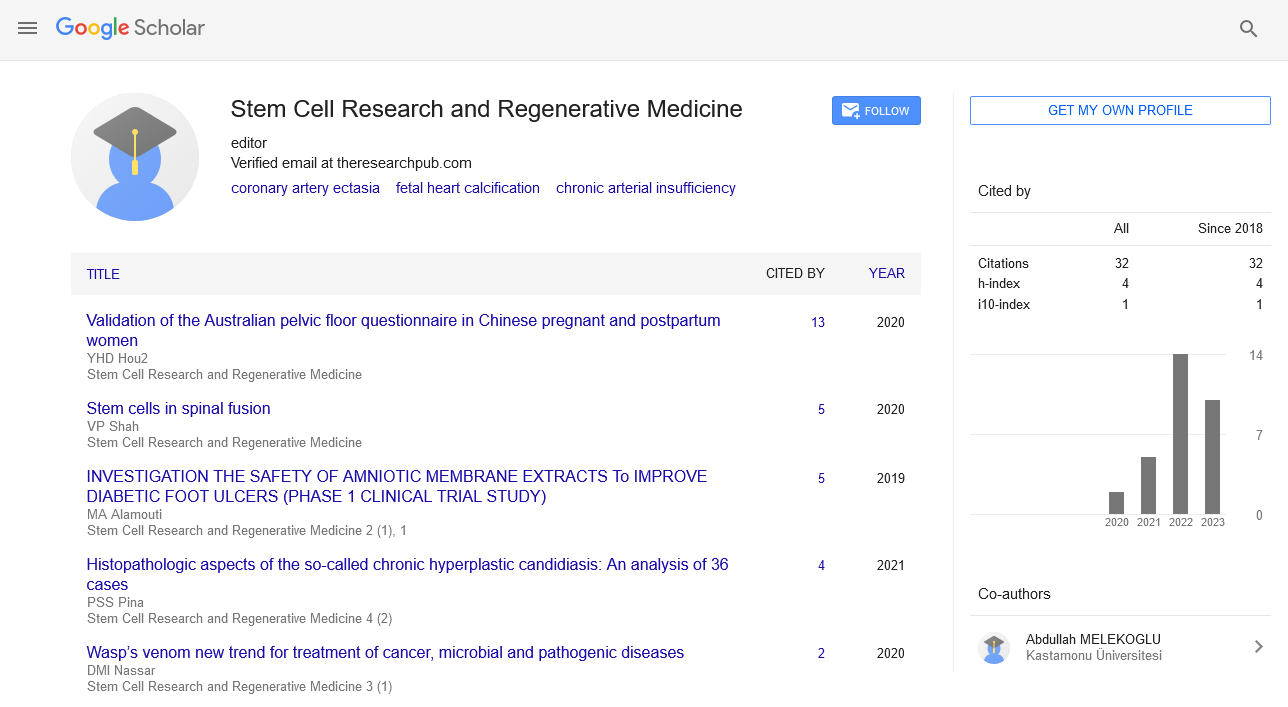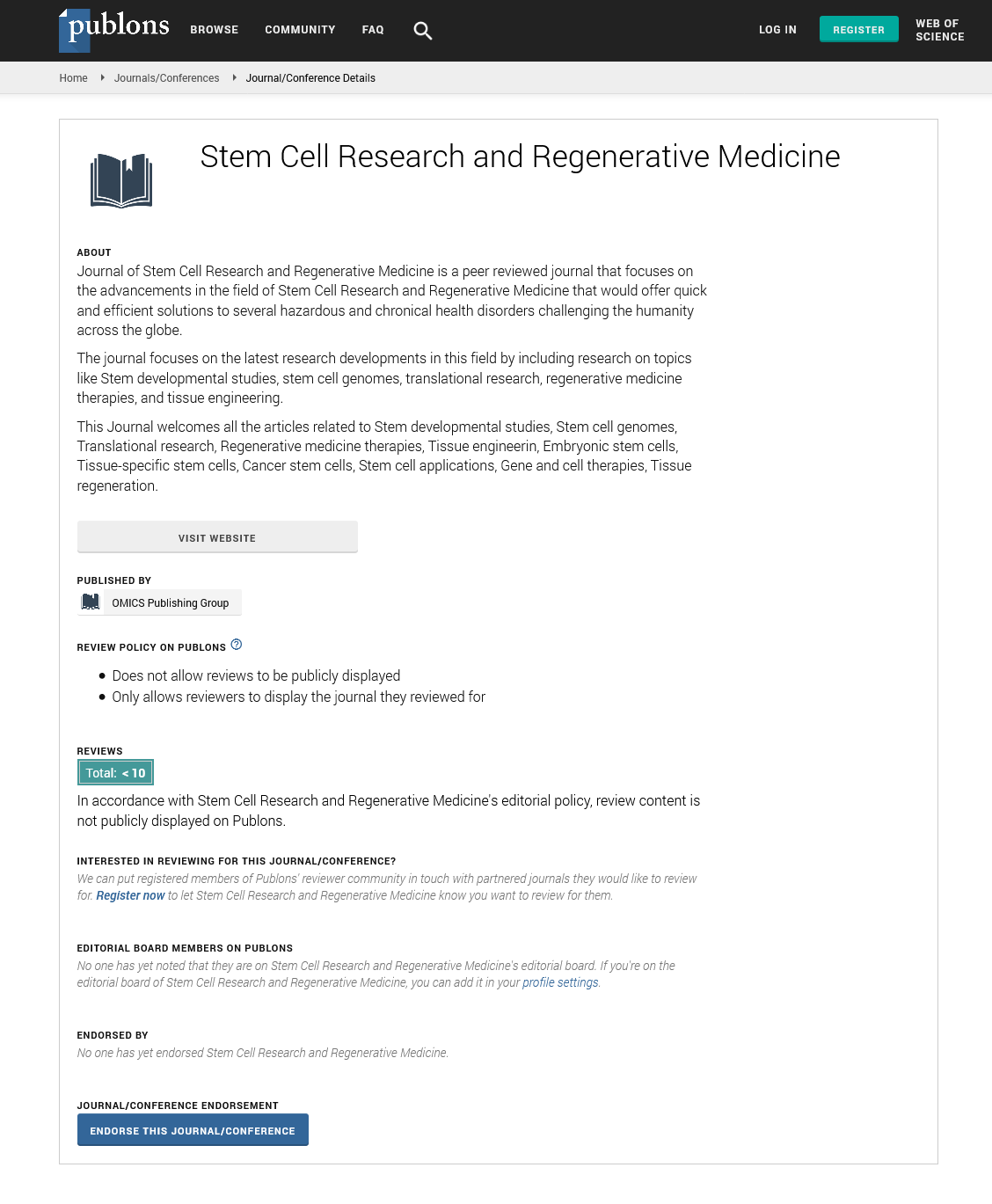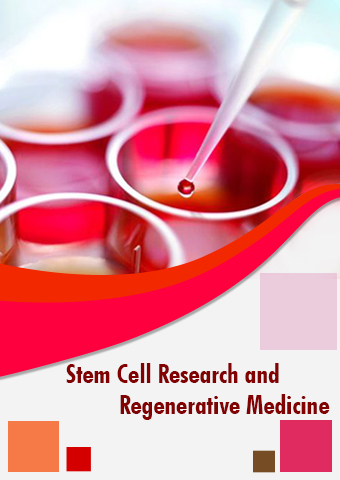Perspective - Stem Cell Research and Regenerative Medicine (2024) Volume 7, Issue 6
Stem Cell Therapies: A Review of Ongoing Clinical Trials and Future Perspectives
- Corresponding Author:
- Animesh Acharjee
Department of Medicine and Prevention, The National Technological University, Buenos Aires, Argentina
E-mail: a.acharjee@gmail
Received: 02-Dec-2024, Manuscript No. SRRM-24-153857; Editor assigned: 04-Dec-2024, Pre QC No. SRRM-24-153857 (PQ); Reviewed: 16-Dec-2024, QC No. SRRM-24-153857; Revised: 23-Dec-2024, Manuscript No. SRRM-24-153857 (R); Published: 31-Dec-2024, DOI: 10.37532/SRRM.2024.7(6).269-271
Introduction
Stem cell therapy has emerged as one of the most promising and dynamic fields in medicine, offering potential treatments for a variety of diseases that were once deemed untreatable. The idea of using stem cells to repair or replace damaged tissues has captivated researchers and clinicians alike, leading to an increasing number of clinical trials worldwide. This article provides an overview of the current landscape of stem cell clinical trials, evaluates the promise they hold, and discusses the challenges that lie ahead.
Description
The promise of stem cell therapy
Stem cells are unique in their ability to self-renew and differentiate into a variety of cell types, making them ideal candidates for regenerative medicine. They can potentially replace damaged cells, repair tissues, and restore lost functions in conditions such as degenerative diseases, autoimmune disorders, and traumatic injuries. The versatility of stem cells has led to their exploration in several therapeutic areas, including:
Neurological disorders: Parkinson’s disease, Alzheimer’s disease, spinal cord injuries, and stroke are among the neurological conditions being targeted by stem cell therapies. The hope is that stem cells can be used to replace lost neurons and restore neural functions.
Cardiovascular diseases: Trials involving the use of stem cells for heart failure, myocardial infarction, and other cardiovascular conditions aim to regenerate damaged heart tissues and improve cardiac function.
Diabetes: Stem cells offer a potential cure for type 1 diabetes by differentiating into insulinproducing beta cells, thus restoring normal insulin levels in patients.
Musculoskeletal disorders: Osteoarthritis, rheumatoid arthritis, and other degenerative musculoskeletal diseases are being addressed with Mesenchymal Stem Cells (MSCs) to regenerate cartilage and repair tissues.
Blood and immune system disorders: Hematopoietic Stem Cells (HSCs) have long been used in bone marrow transplants to treat leukemia and other blood disorders. New trials are exploring gene-edited stem cells to correct genetic disorders and enhance immune function.
Ongoing clinical trials: A snapshot
The clinical trials involving stem cell therapies can be categorized based on the type of stem cells used and the target diseases. A quick overview of some ongoing and noteworthy trials includes:
Mesenchymal Stem Cells (MSCs)
Target conditions: Arthritis, Crohn’s disease, graft-versus-host disease, cardiovascular diseases.
Highlights: MSCs have been a focus due to their immunomodulatory properties and ability to differentiate into bone, cartilage, and fat cells. Clinical trials are evaluating their efficacy in treating inflammatory conditions, degenerative joint diseases, and heart failure.
Hematopoietic Stem Cells (HSCs)
Target conditions: Leukemia, lymphoma, multiple sclerosis, sickle cell anemia.
Highlights: HSC transplants are well-established in hematological conditions, but current trials are exploring gene-edited HSCs for inherited blood disorders. Trials for autoimmune conditions like multiple sclerosis show promise in resetting the immune system.
Neural Stem Cells (NSCs)
Target conditions: Parkinson’s disease, spinal cord injury, stroke.
Highlights: NSCs are being tested for their ability to regenerate neurons in neurodegenerative diseases. Early-phase trials are showing potential for improved motor function and cognitive recovery.
Pluripotent Stem Cells (iPSCs and ESCs)
Target conditions: Age-related macular degeneration, diabetes, heart disease.
Highlights: Induced Pluripotent Stem Cells (iPSCs) and Embryonic Stem Cells (ESCs) have the capacity to differentiate into almost any cell type. Trials are ongoing to address conditions like macular degeneration and heart disease with iPSC-derived cells, though ethical and safety concerns persist.
Key clinical trials and breakthroughs
Several high-profile clinical trials are worth noting due to their potential to change the landscape of stem cell therapy:
Heart regeneration trials: Trials using MSCs and cardiac stem cells to treat heart failure have shown encouraging results, with some studies reporting improved cardiac function and reduced scar tissue. However, the mixed outcomes from various trials underscore the need for standardized protocols.
Neurological regeneration trials: In Parkinson’s disease, trials using dopaminergic neurons derived from iPSCs have shown preliminary success in animal models, and human trials are underway. For spinal cord injuries, stem cell therapies are aiming to restore mobility, with some patients experiencing significant improvement.
Ophthalmology trials: Stem cell-derived retinal cells are being tested to treat macular degeneration and other retinal disorders. A recent trial using retinal pigment epithelium cells derived from iPSCs has demonstrated vision restoration in patients with age-related macular degeneration.
Challenges and ethical considerations
Despite the promise, stem cell therapies face several challenges:
Safety and efficacy: One of the primary concerns in stem cell therapy is ensuring the safety and efficacy of the treatment. Risks such as tumor formation, immune rejection, and unforeseen side effects need to be addressed through rigorous preclinical and clinical testing.
Standardization and quality control: The variability in protocols, stem cell sources, and delivery methods can lead to inconsistent results across trials. Standardizing production, quality control, and storage conditions is essential for reproducibility and scalability.
Ethical issues: The use of embryonic stem cells raises ethical questions related to the destruction of embryos. While iPSCs have addressed some ethical concerns, their genetic stability and long-term safety remain under scrutiny.
Regulatory and commercialization hurdles: Navigating the regulatory landscape for stem cell therapies can be challenging, with varying standards across countries. Commercialization faces obstacles such as high costs, complex manufacturing processes, and ensuring equitable access to treatments.
Future perspectives: Where is stem cell therapy heading?
The future of stem cell therapy is promising but uncertain. A few areas that are likely to drive the field forward include:
Gene-edited stem cells: The combination of gene editing technologies like CRISPR-Cas9 with stem cell therapy holds the potential to correct genetic defects at their source. This approach is particularly promising for genetic disorders like cystic fibrosis, muscular dystrophy, and hemophilia.
Organoids and tissue engineering: Advances in 3D bio-printing and organoid research could revolutionize the field of regenerative medicine. Organoids derived from stem cells can mimic complex tissues, providing platforms for drug testing, disease modeling, and potential transplantation.
Personalized medicine: With the advent of iPSCs, personalized stem cell therapies are becoming a reality. Patients’ cells can be reprogrammed and used for disease-specific treatments, minimizing the risk of immune rejection.
Combination therapies: Future clinical trials may explore combination therapies, integrating stem cells with biomaterials, growth factors, and pharmacological agents to enhance outcomes. The synergy of these approaches could lead to more effective and lasting regenerative solutions.
Conclusion
Stem cell therapy is at the forefront of medical innovation, holding the promise to revolutionize how we treat a range of diseases. While the field faces significant challenges, the progress made in on-going clinical trials is undeniable. Continued research, ethical consideration, and international collaboration will be key to unlocking the full potential of stem cell therapies. The next decade may very well witness a transition from experimental treatments to standard clinical practices, changing the face of medicine as we know it.


